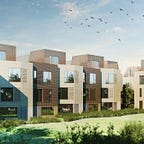Building a better world
Article written by Sylvain Bogeat, co-founder of Vesta Construction Technologies. Subscribe to our newsletter to get all news from our incubees and the HEC incubator.
The construction sector is facing three issues
- Soaring construction and housing prices
- Slow and unreliable development timetable
- Dreadful environmental footprint
Taking a step back, one of the shared features of these issues is the multiplicity of players and the lack of coordination between them. The very low penetration rate of digital tools, lack of vertical integration and poor upfront coordination are accountable for the lacklustre productivity gains we have witnessed over a century.
Once again, US (and Canadian) entrepreneurs are showing us the way. Maisons Bonneville or more recently players like Katerra or Prescient have understood and unleashed huge productivity gains in the construction sector.
Constructing buildings the way cars are made
The first step towards a modern construction industry is to better integrate the design and construction phase. The traditional split between these two phases is mostly irrelevant in today’s world. It made sense to design a cathedral before building it, however no one would expect to hand draw the blueprints of a Ford before having it custom built. We need to switch to design for manufacturing. The construction phase is an opportunity to integrate game-changing technologies to reduce the carbon footprint, improve comfort or maximize efficiency. But it needs to be implemented as early as the design phase.
Streamlining the construction process
The second step is linked to a shift from craftsmanship to industrial production. It’s shameful to see so much time and energy wasted on construction projects: workers having to start every project like a new prototype ; going back and forth between multiple construction sites ; losing time to resupply ; waiting for colleagues to finish their part. We need to streamline the construction process, and develop buildings like we assemble cars. This is the only way to reduce rising construction costs and to absorb the additional expenses necessary to shift to environment-friendly construction materials.
Building As A Service
The last step is to think of the construction and building as a service. When design is vertically integrated, construction becomes a turnkey service for developers. This allows them to focus on what they do best: source projects, draw guidelines, and sell them to an end client. Going a step further, one could argue that the building in itself is a service. We progressively witnessed a switch from an ownership model to leasing models, for aircraft, offices, cars etc. On the one hand, in an agile and specialized society, buying and maintaining a flat or building makes less and less sense. On the other hand, once the construction phase is vertically integrated, development and operations partnerships make a lot of sense, as the construction company knows how to maintain the building.
Vesta Construction Technologies : the sole player in the entire construction process
At Vesta Construction Technologies, we strive to accelerate the pace at which the construction industry is evolving. We are working hard to seize opportunities to digitalize, industrialize and create new business models. We have developed a strong and growing network of clients and partners, and we will work with anyone who wants to build a better world along with us.
What would you say to divide by 3 the carbon footprint of new construction, to divide by 2 the construction time, and to free yourself from the noisiest and most polluting stages of the work, at no extra cost?
Share your projects with us, we will build them together.
Sylvain Bogeat, co-founder of Vesta Construction Technologies
Stay in touch : hello@vestaconstructiontech.com or follow us for more news
